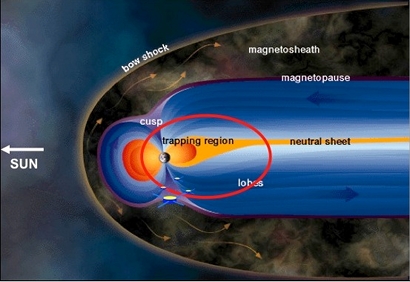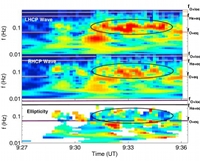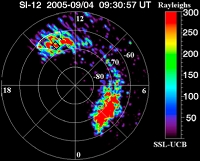Cluster makes crucial step in understanding space weather
26 July 2010
Researchers using the four spacecraft of ESA's Cluster mission have uncovered the long journey that energetic ions undergo during geomagnetic storms and how they ultimately precipitate into the Earth's atmosphere. Such precipitation affects the composition of the ionosphere, preventing GPS and communications satellites from operating correctly.The Earth's magnetic field acts a buffer zone, shielding the Earth from the permanent flow of ionised matter coming from the Sun. As a result of the interaction of the solar wind with the Earth's field, a protective bubble known as the magnetosphere is formed. This comprises a complex mixture of electric and magnetic fields, charged particles and resultant current systems. One such system, the so-called Ring current, forms in a doughnut shape around the Earth, and is caused by trapped particles, from either the solar wind or from the Earth's ionosphere, gyrating around the magnetic field lines of the Earth. Changes in the ring current are responsible for global decreases in the Earth's surface magnetic field.
 |
| Illustration of the Earth's magnetosphere immersed in the solar wind. Credit: ESA |
During periods of quiet geomagnetic activity, the ring current is carried by protons (H+ ions) from the solar wind. During geomagnetic storms an abundance of oxygen ions (O+) is observed, which come from the ionosphere. However, it has not been clear up to now how this O+ gets there.
In a recently published paper, Lynn Kistler (University of New Hampshire, USA) and her colleagues have used Cluster data to present a detailed picture of the journey these ions make to get to the ring current.
| The journey of ions through space during geomagetic storms. Credit: NASA (For larger versions of this video click here) |
The journey takes the ions flowing out of the ionosphere from the polar regions or cusps of the Earth’s magnetic field during storm periods, then into the tear-drop shaped magnetic tail of the magnetosphere where they are energised and eventually injected into the ring current, resulting in the observed abundance.
"There are O+ ions out-flowing constantly from the atmosphere but during a geomagnetic storm the outflow is much more intense," Kistler says. "This is a tracer of a geomagnetic storm; if you have much more oxygen out-flowing then this is a clear indication that there is a storm on-going," she added.
The effect of this increased abundance of O+ on the ring current is to completely alter the manner in which it interacts with the local magnetosphere. One such effect is to enhance the occurrence and intensity of electromagnetic waves which interact with the ions. This so-called wave particle interaction has been the focus of another Cluster study led by Zhigang Yuan of Wuhan University in China, which has confirmed a long standing result based on computer simulations.
In such an interaction, the waves scatter the particles out of the ring current and into the atmosphere to disperse the storm-enhanced ring current. In the study, Cluster instruments identified the waves while the resultant precipitation, near the Earth's auroral regions, was captured simultaneously by the NASA IMAGE satellite.
When such an event occurs the ions interact with the Earth's atmosphere and alter its physical characteristics. "If there are a lot of ions precipitating down then it can change the conductivity of the ionosphere," explains Yuan. This has a profound effect on GPS and satellite communication as it extends the signal travel time through the ionosphere, leading to positioning errors. A better understanding of this space weather phenomenon can allow the effect to be taken into account and help minimise the effect geomagnetic activity has on our technology-dependent society.
"The Cluster mission is a major contribution of ESA to the International Living with a Star programme. This programme is a collaboration of the world-wide scientific community to understand the science behind space weather. With 10 years of operations - and still going strong - Cluster will provide the first set of multipoint measurements in the Earth's magnetic environment over a full solar cycle," comments Philippe Escoubet, ESA Cluster Mission Manager. "This is a unique contribution to our ability to model and to understand space weather."
Related publications
Kistler, L.M., Mouikis, C.G., Klecker, B., Dandouras, I., "Cusp as a source for oxygen in the plasma sheet during geomagnetic storms," J. Geophys. Res., 115, A03209, 2010. DOI:10.1029/2009JA014838
Yuan, Z., Deng, X., Lin, X., Pang, Y., Zhou, M., Décréau, P., Trotignon, J.-G., Lucek, E., Frey, H.U., Wang, J., "Link between EMIC waves in a plasmaspheric plume and a detached sub-auroral proton arc with observations of Cluster and IMAGE satellites", Geophys. Res. Lett., 37, L07108, 2010. DOI:10.1029/2010GL042711
Notes for editors
Cluster is the first space mission able to study, in three dimensions, the natural physical processes occurring within and in the near vicinity of the Earth’s magnetosphere. It is a project of international collaboration between ESA and NASA. Launched in 2000, it is composed of four identical spacecraft orbiting the Earth in a pyramidal configuration, along a nominal polar orbit of 4 × 19.6 Earth radii (1 Earth radius = 6380 km). Cluster’s payload consists of state-of-the-art plasma instrumentation to measure electric and magnetic fields over a wide frequency range, and key physical parameters characterizing electrons and ions from energies of nearly 0 eV to a few MeV. The science operations are coordinated by the Joint Science Operations Centre (JSOC), at the Rutherford Appleton Laboratory, United Kingdom, and implemented by ESA’s European Space Operations Centre (ESOC), in Darmstadt, Germany.
Contacts
Lynn Kistler
University of New Hampshire, USA
Email: lynn.kistler unh.edu
unh.edu
Zhigang Yuan,
Wuhan University, China
Email: y_zgang vip.163.com
vip.163.com
Matthew Taylor, Cluster Project Scientist
Directorate of Science and Robotic Exploration, ESA, The Netherlands
Email: Matthew.Taylor esa.int
esa.int




